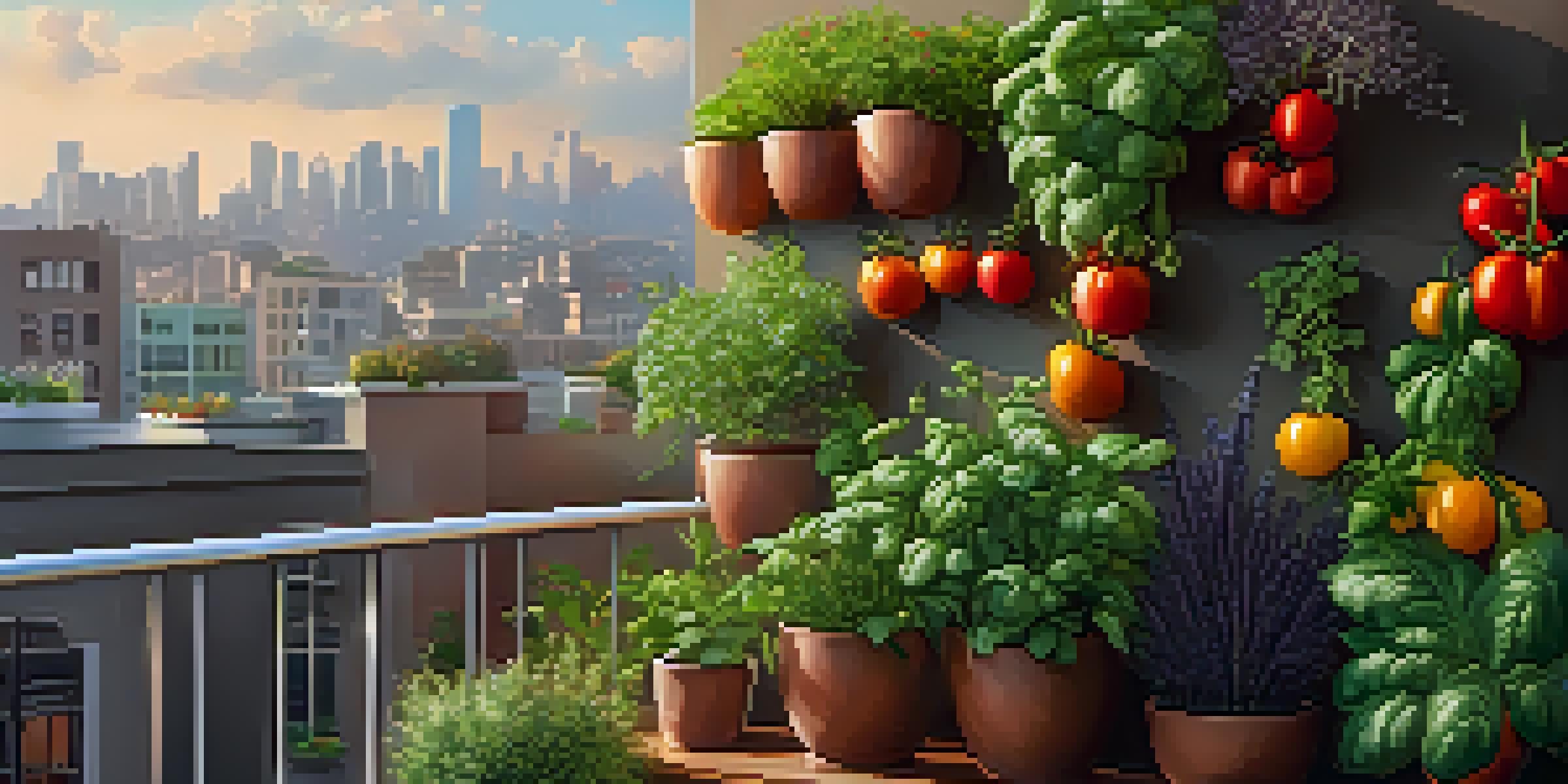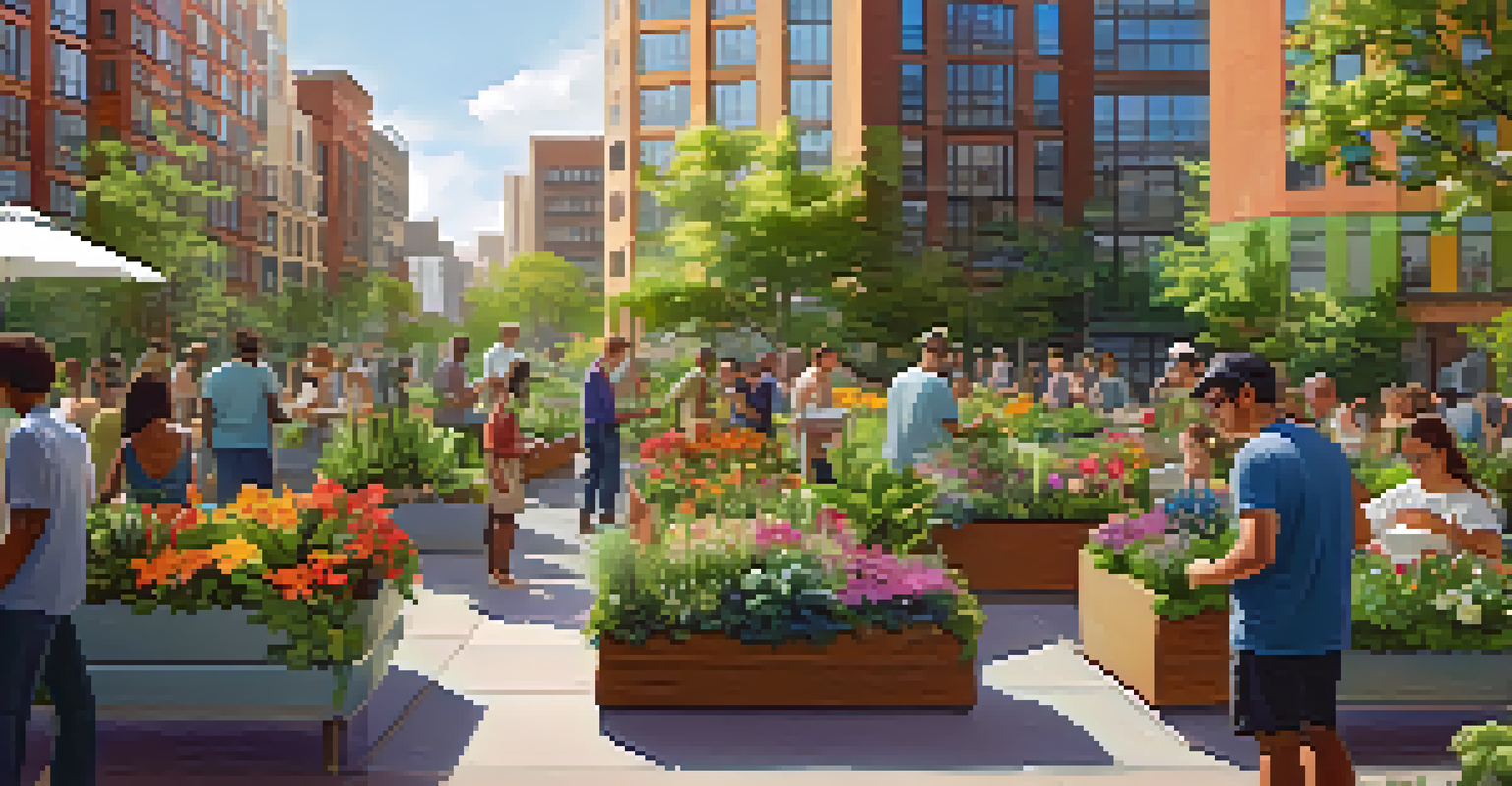Maximizing Space: Vertical Gardening Techniques for Urban Areas

Understanding Vertical Gardening and Its Benefits
Vertical gardening is a method of growing plants upwards rather than outwards, making it ideal for urban settings where space is limited. By utilizing walls, fences, and even railings, you can create a lush green oasis in the heart of the city. This practice not only maximizes space but also enhances air quality and reduces noise pollution.
Gardening is a way of showing that you believe in tomorrow.
One of the standout benefits of vertical gardening is its ability to produce fresh herbs and vegetables in small areas. Imagine plucking basil or tomatoes right from your balcony! This not only promotes a healthier lifestyle but also reduces the carbon footprint associated with transporting food.
Moreover, vertical gardens can significantly improve the aesthetic appeal of your living space. They offer a vibrant touch of nature, creating a soothing environment that can reduce stress and improve overall well-being.
Choosing the Right Plants for Vertical Gardens
Selecting the right plants is crucial for a thriving vertical garden. Opt for varieties that grow well in confined spaces and can tolerate vertical growth, such as herbs, succulents, and climbing plants like peas and beans. These plants not only look great but also provide a bountiful harvest.

Consider the amount of sunlight your vertical garden will receive. Some plants, like sunflowers, thrive in full sun, while others, such as ferns, prefer shade. Understanding your space's light conditions will help you make informed choices, ensuring your plants flourish.
Maximize Space with Vertical Gardening
Vertical gardening utilizes walls and structures to grow plants upwards, making it perfect for urban areas with limited space.
Lastly, think about the maintenance each plant requires. Some species are low-maintenance and perfect for beginners, while others might need more attention. Balancing your gardening ambitions with your available time will lead to a more satisfying experience.
Essential Vertical Gardening Tools and Materials
Before starting your vertical garden, having the right tools and materials will set you up for success. Basic items include pots, trellises, and wall planters, all designed to support upward growth. Additionally, lightweight soil is essential, as it allows for better drainage and reduces the overall weight on your structure.
The best time to plant a tree was twenty years ago. The second best time is now.
Don't forget about irrigation systems! Drip irrigation or self-watering planters can save you time and ensure your plants receive consistent moisture. This is particularly important in urban areas where heat can quickly dry out soil.
Lastly, consider using organic fertilizers and pest control options that are safe for urban gardening. This ensures that your garden remains healthy and sustainable, contributing positively to your local ecosystem.
Designing Your Vertical Garden Space
Designing your vertical garden can be one of the most enjoyable parts of the process. Start by assessing the available space and envision how you want your garden to look. Consider using a variety of heights and textures to create visual interest and depth.
You can also incorporate art into your design by adding decorative elements like painted pots or wall murals. This not only personalizes your garden but also transforms an ordinary space into a vibrant outdoor retreat.
Choose Plants Wisely for Success
Selecting the right plants that thrive in confined spaces and understanding their light and maintenance needs is crucial for a flourishing vertical garden.
Lastly, think about accessibility. Make sure that your plants are easy to reach for watering and harvesting, as this will encourage you to maintain your garden regularly. A well-designed space will invite you to engage with your plants more often.
Maintaining Your Vertical Garden Year-Round
Maintaining a vertical garden requires some planning, especially as seasons change. Regular watering, pruning, and checking for pests are essential tasks that will keep your plants healthy and thriving. Consider creating a maintenance schedule to help you stay on track throughout the year.
During warmer months, ensure that your plants receive adequate hydration, as vertical gardens can dry out quickly. Conversely, in colder months, be prepared to protect sensitive plants from frost by bringing them indoors or covering them with protective materials.
Additionally, rotate your plants to optimize sunlight exposure. This simple practice not only promotes even growth but also prevents any one plant from overshadowing its neighbors, allowing your vertical garden to flourish as a cohesive unit.
Common Challenges in Vertical Gardening
While vertical gardening is rewarding, it does come with its challenges. One of the most common issues is inadequate sunlight, which can stunt growth. If you find your plants struggling, consider relocating them or supplementing with grow lights to ensure they receive enough light.
Overwatering is another frequent pitfall, especially in vertical gardens where drainage can be an issue. Always check the moisture level of your soil before watering, and consider using pots with drainage holes to prevent root rot.
Design and Maintain Your Garden
A well-designed vertical garden not only enhances aesthetics but also requires consistent maintenance to thrive year-round.
Lastly, pests can sometimes be problematic. Regularly inspect your plants for signs of infestations and use organic pest control methods to keep your garden healthy without using harmful chemicals.
Inspiring Examples of Urban Vertical Gardens
Looking for inspiration? Cities around the world are embracing vertical gardens in innovative ways. For instance, the famous Bosco Verticale in Milan features residential towers adorned with lush greenery, creating a stunning visual impact while promoting biodiversity.
Closer to home, community gardens often utilize vertical gardening techniques to make the most of limited space. These projects not only beautify neighborhoods but also foster community spirit by bringing people together to share in the gardening experience.

You can also find many DIY vertical gardens on social media platforms. From repurposed pallets to hanging shoe organizers, the creativity is endless. These ideas can spark your imagination and help you design a garden that reflects your unique style.